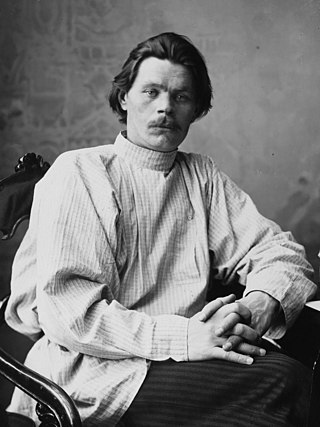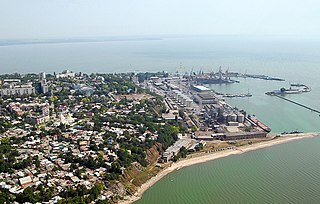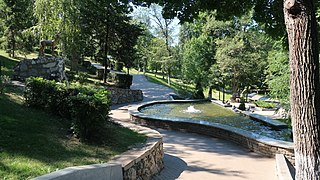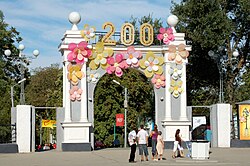History
On June 30, 1806, the first trees were planted for the Taganrog's "Chemist’s garden" and "botanical garden" by the order of Taganrog's governor baron Balthasar von Campenhausen In 1895 the project of the new garden's planning according to new European standards was approved. In 1903, Monument to Peter the Great was placed on Petrovskaya Street in front of the main entrance to the park.
In 1924, the Peter the Great monument was dismantled and removed. [1] In 1932, the municipal garden became the Park of Culture and Recreation and in 1934 it was named Gorky Park after Maxim Gorky. In 1941–1943, during the Occupation of Taganrog, the City Park was partially destroyed and was used by the occupation forces of Nazi Germany as a cemetery (Der Deutsche Heldenfriedhof). In 2006, the Gorky Park celebrated its bicentenary anniversary. [2]

Alexei Maximovich Peshkov, popularly known as Maxim Gorky, was a Russian and Soviet writer and socialist political thinker and proponent. He was nominated five times for the Nobel Prize in Literature. Before his success as an author, he travelled widely across the Russian Empire changing jobs frequently, experiences which would later influence his writing.

Taganrog is a port city in Rostov Oblast, Russia, on the north shore of Taganrog Bay in the Sea of Azov, several kilometers west of the mouth of the Don River. It is in the Black Sea region. Population: 245,120 (2021 Census); 257,681 (2010 Census); 281,947 (2002 Census); 291,622 (1989 Census).

Gorky Central Park of Culture and Leisure is a central park in Moscow, named after Maxim Gorky. In August 2018, the Park's 90th anniversary was celebrated.

Konstantin Georgiyevich Paustovsky was a Soviet writer nominated for the Nobel Prize for literature in 1965.

Faina Georgievna Ranevskaya, is recognized as one of the greatest Soviet actresses in both tragedy and comedy. She was also famous for her aphorisms.

The southern Russian city of Taganrog began as one of Russia's first planned cities under Peter the Great. To protect the newly conquered Sea of Azov region, the Russians opened a naval base there in 1698 and a city and seaport were built. However, after the Turkish victory in the war of 1710–1711, Taganrog city and port were demolished prior to handover to the Turks.

The Peter I Monument, also known as the Peter the Great Monument, is a monument to Peter I of Russia located in Taganrog, Russia. It is a bronze statue created by the sculptor Mark Antokolsky and first installed in 1903.

Ivan Karpovich Golubets was a Soviet sailor with the Black Sea Fleet. He was posthumously made a Hero of the Soviet Union.

Alferaki Palace is a museum in Taganrog, Russia, originally the home of the wealthy merchant Nikolay Alferaki. It was built in 1848 by the architect Andrei Stackenschneider on Frunze Street, in downtown Taganrog.

The Chekhov Gymnasium in Taganrog on Ulitsa Oktyabrskaya 9 is the oldest gymnasium in the South of Russia. Playwright and short-story writer Anton Chekhov spent 11 years in the school, which was later named after him and transformed into a literary museum. Visitors can see Anton's desk and his classroom, the assembly hall and even the punishment cell which he sometimes visited.

Taganrog Museum of Art was officially inaugurated in 1968, but the basis of the museum collection was formed by the end of the 19th century, when the art department of the Taganrog's city museum was established.

The Mariinskaya Gymnasium in Taganrog on Chekhov Str. 104 - currently school No. 15 of the North Caucasus Railway – originated from two oldest educational establishments in the South of Russia: the Mariinskaya Gymnasium for Girls and the Railway Vocational School.

The Soviet city of Taganrog, now part of the Rostov Oblast of the Russian Federation, had an eventful history during World War II, from 1941 to 1945.

The Greek Church of Sts Constantine and Helena, also known as the Greek Church and Greek School, was a Greek Orthodox church and school located in Taganrog, Russia from 1781 to 1938.

Taganrog underground resistance movement was an Antifascist underground group of young Komsomol members acting in occupied Taganrog in 1941-1943.
The Leninist Komsomol park is a popular recreation area in Donetsk. It was considered back in 1952, when Central Scherbakov Park of Culture and Leisure could no more fully address the city needs because "Shakhtar" stadium was built on its territory. The park was laid out only in 1956 due to numerous modifications of design; the same year the 20th anniversary of Maxim Gorky death was commemorated, so the park was first named after M. Gorky. In 1958 the 40th Anniversary of Leninist Komsomol alley was established, and the park was subsequently renamed to Lenin Komsomol Park.

Gully of Petrushino is a site on the outskirts of Taganrog, Russia, at which 7,000 Soviet civilians, mostly Jews, were massacred between 1941 and 1943 by the German army, with the assistance of non-German divisions, during their occupation of Taganrog.

Strukovsky Garden is a central urban park in Samara, Russia, named after Russian colonel and Active State Councillor Grigory Nikanorovich Strukov. It is the oldest park in the city. The park was established in 1849 in the city Centre. It is located in the Leninsky District between Vilonovskaya Street, Krasnoarmeyskaya Street, Maxima Gorkogo Street and Kuybysheva Street.
The Alley of Immortality is a memorial square located in the park adjacent to Taganrog's school №34. Small parcels of earth gathered from the USSR's Hero Cities and other historically significant places have been collected and arranged to form the plaza. The Alley of Immortality is a place for holding memorable services and laying flowers.

Taganrog Lighthouse is a lost lighthouse in Taganrog, Rostov region located near the monument to Peter the Great and destroyed in 1970 because it was in a critical condition.































